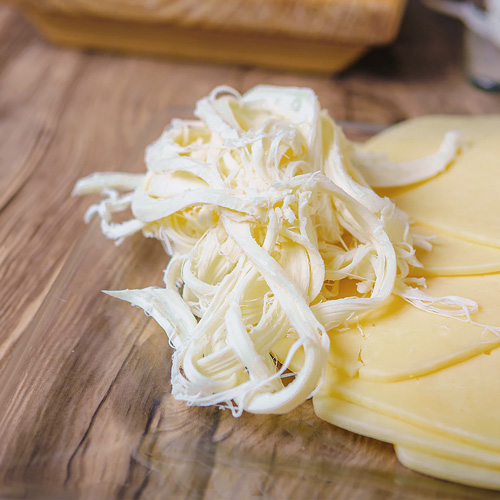
Mexican cuisine is known for its rich, bold flavors, and its cheeses are no exception. From soft, creamy varieties to sharp and aged selections, each cheese brings something unique to the table. Understanding the different types of Mexican cheese allows foodservice operators to pair the right cheese with each dish and provide customers with an authentic dining experience. Whether you're adding a creamy texture or a salty punch, Mexican cheeses are delicious ingredients to add to Latin-inspired meals.
Shop All Mexican CheesesTypes of Mexican Cheese
From mild queso fresco to semi-soft queso Chihuahua, check out the types of Mexican cheese found throughout cultural cuisine.
1. Queso Fresco

Queso fresco, meaning "fresh cheese," is a mild, crumbly cheese commonly used in Mexican cuisine. It is a fresh, unaged cheese made from cow’s milk or a cow and goat milk blend. Unlike melting cheeses, queso fresco stays firm when heated, making it ideal for crumbling over dishes. Its slightly tangy, milky flavor enhances tacos, burritos, enchiladas, and salads.
- What Does Queso Fresco Look Like? A soft, white, crumbly cheese with a slightly moist texture.
- What Does Queso Fresco Taste Like? Mild, fresh, tangy, and slightly salty.
- How to Use Queso Fresco: Crumble over hot or cold dishes like soups, beans, and salads. It does not melt well but softens when warmed.
- Queso Fresco Dishes: Tacos, enchiladas, tostadas, elote, and chiles rellenos.
Queso Fresco Substitute
For similar results in dishes, substitute queso fresco with feta, ricotta salata, or paneer. These cheeses provide the same crumbly texture and slightly salty taste. Queso blanco also works as a substitute due to its similar profile, but it has a different texture and melting quality.
2. Manchego

Mexican manchego is a semi-soft, pale yellow cheese with a smooth texture and mild, buttery flavor. Unlike Spanish manchego, which is made from sheep’s milk, the Mexican version comes from cow’s milk. It melts well, making it ideal for quesadillas, sandwiches, and baked dishes. Its mild flavor pairs well with many ingredients, making it a versatile choice in kitchens.
- What Does Manchego Look Like? A smooth, pale yellow cheese with a semi-soft texture.
- What Does Manchego Taste Like? Buttery, mild, slightly nutty, and creamy.
- How to Use Manchego: Ideal for melting in hot dishes like quesadillas and casseroles or sliced for sandwiches.
- Manchego Dishes: Quesadillas, tapas, tortas, chiles rellenos, and baked pasta dishes.
Manchego Substitute
For similar melting qualities and mild flavor, use Monterey Jack, gouda, or muenster as substitutes. These cheeses provide a comparable creamy texture and mild taste. Cheeses like parmesan, Pecorino Romano, and Parmigiano-Reggiano are good substitutes with a stronger flavor, so they may change the flavor profile of your dish.
3. Cotija

Cotija is a firm, crumbly cheese from Michoacán, Mexico, known for its salty, bold flavor. Often called the “Parmesan of Mexico,” it does not melt but adds a sharp, savory touch when crumbled over dishes. Its strong, tangy taste enhances multiple items, from street corn to tacos. Aged cotija develops an even firmer texture and a more intense flavor, making it ideal for grating.
- What Does Cotija Look Like? A firm, white cheese with a crumbly texture.
- What Does Cotija Taste Like? Salty, tangy, bold, and slightly sharp.
- How to Use Cotija: Best crumbled over dishes like tacos, soups, and elote to add a savory bite.
- Cotija Dishes: Elote (Mexican street corn), tacos, enchiladas, refried beans, and salads.
Cotija Cheese Substitute
Use feta or parmesan for a similar salty, crumbly texture. These cheeses mimic cotija’s ability to enhance dishes with a sharp, savory flavor. Queso fresco is also a good substitute due to its similar consistency, but it will change the flavor profile.
Cotija vs Queso Fresco
Both are crumbly Mexican cheeses, but cotija is saltier and firmer, while queso fresco is milder and softer. Cotija is aged, which gives it a stronger flavor, whereas queso fresco has a fresh, slightly tangy taste. Queso fresco melts slightly when heated, but cotija maintains its firm texture.
Cotija vs Feta
Cotija and feta share a crumbly texture and salty taste, but feta has a creamier consistency and a tangier, more acidic flavor. Cotija is drier and ages into a firmer texture, while feta remains soft due to its brining process. While both cheeses work as toppings, cotija’s boldness pairs well with Mexican cuisine, whereas feta is better suited for Mediterranean dishes.
4. Panela

Panela is a fresh, mild Mexican cheese known for its soft yet firm texture and ability to hold its shape when heated. Made from cow’s milk, it has a slightly salty, milky flavor and a smooth surface that absorbs the flavors of marinades and seasonings. Unlike other fresh cheeses, panela does not crumble easily, making it ideal for grilling or slicing. It is commonly used in salads, sandwiches, and as a filling for tacos and enchiladas.
- What Does Panela Look Like? A smooth, white, semi-firm cheese that holds its shape when sliced.
- What Does Panela Taste Like? Mild, slightly salty, fresh, and milky.
- How to Use Panela: Best sliced or grilled; absorbs flavors well and retains its shape when heated.
- Panela Dishes: Grilled panela, tacos, tortas, salads, and enchiladas.
Panela vs Queso Fresco
While panela and queso fresco might look similar at first glance, panela is firmer and holds its shape when cooked. In contrast, queso fresco is softer and crumbles easily. Panela has a mild, milky flavor and absorbs seasonings well, whereas queso fresco has a slightly tangier taste. Panela works well for grilling or slicing, while queso fresco is better for crumbling over dishes.
5. Queso Oaxaca

Queso Oaxaca, also known as Oaxaca cheese or queso de hebra, is a semi-soft, stringy cheese from the Oaxaca region of Mexico. Made from cow’s milk, it has a mild, buttery flavor and a texture similar to mozzarella, making it ideal for melting. This cheese is often pulled into thin strands and used in dishes that require a creamy, stretchy consistency. It is a staple in quesadillas, empanadas, and other melted cheese dishes.
- What Does Queso Oaxaca Look Like? A white, semi-soft cheese wound into a ball of string-like strands.
- What Does Queso Oaxaca Taste Like? Buttery, mild, slightly salty, and creamy.
- How to Use Queso Oaxaca: Best for melting; works well in quesadillas, fundido, and baked dishes.
- Queso Oaxaca Dishes: Quesadillas, tlayudas, chile rellenos, and enchiladas.
Queso Oaxaca vs Mozzarella
Both cheeses have a stringy, stretchable texture and melt well, making them excellent choices for baking and melting applications. However, queso Oaxaca has a slightly saltier and richer flavor, while mozzarella is more neutral and milky. Mozzarella is often used in Italian cuisine, while queso Oaxaca is a staple in Mexican dishes. Queso Oaxaca’s string cheese-like consistency makes it easy to shred by hand, while mozzarella is usually sliced or grated.
Back to Top6. Requeson

Requeson is a soft, fresh cheese similar to ricotta, made by reheating the whey left over from cheesemaking. It has a creamy, slightly grainy texture and a mild, milky flavor with a hint of sweetness. This cheese is commonly used as a filling for tamales, enchiladas, and pastries or as a spread for tortillas and tostadas. Its smooth consistency makes it a versatile ingredient in savory and sweet dishes.
- What Does Requeson Look Like? White, soft, and slightly grainy with a spreadable consistency.
- What Does Requeson Taste Like? Mild, creamy, slightly sweet, and fresh.
- How to Use Requeson: Ideal for spreading, stuffing, or blending into dips and sauces.
- Requeson Dishes: Tamales, enchiladas, empanadas, tostadas, and desserts like cheesecakes or stuffed pastries.
7. Queso Chihuahua

Queso Chihuahua, also known as queso menonita, is a semi-soft cheese from the Mexican state of Chihuahua. It has a smooth, firm texture and a rich, buttery flavor with mild tanginess. Known for its excellent melting properties, it is commonly used in dishes that require gooey, stretchy cheese. It works well in quesadillas, fundidos, and baked dishes, adding a creamy, flavorful touch.
- What Does Queso Chihuahua Look Like? Pale yellow, smooth, and firm with a slightly elastic texture.
- What Does Queso Chihuahua Taste Like? Buttery, mild, slightly tangy, and creamy.
- How to Use Queso Chihuahua: Ideal for melting in quesadillas, fundidos, and casseroles or shredding over baked dishes.
- Queso Chihuahua Dishes: Quesadillas, queso fundido, chile rellenos, nachos, and baked pasta dishes.
Queso Chihuahua vs Oaxaca
Both queso Chihuahua and queso Oaxaca are known for their excellent melting qualities, making them popular in Mexican cuisine. Queso Oaxaca has a stringy, pull-apart texture similar to mozzarella, while queso Chihuahua is denser and creamier. Chihuahua cheese has a slightly stronger, more buttery flavor, whereas Oaxaca cheese is milder. When a recipe calls for stretch and elasticity, Oaxaca is the better choice, but for a rich, smooth melt, Chihuahua cheese is ideal.
8. Queso Crema

Queso crema is a soft, spreadable Mexican cheese with a rich, creamy texture and mild flavor. It is similar to cream cheese but slightly tangier and more delicate. This cheese enhances savory and sweet dishes, offering a smooth consistency that blends well in sauces, dips, and desserts. Foodservice operators use it in enchiladas, tamales, and pastries to add a luscious, creamy element.
- What Does Queso Crema Look Like? Smooth, white, and spreadable with a soft, dense consistency.
- What Does Queso Crema Taste Like? Mild, creamy, slightly tangy, and rich.
- How to Use Queso Crema: Perfect for spreading on bread, blending into sauces, or using as a topping for tacos, tamales, and enchiladas.
- Queso Crema Dishes: Enchiladas suizas, tamales, chiles en nogada, tres leches cake, and flan.
9. Queso Asadero

Queso asadero is a semi-soft Mexican cheese known for its excellent melting properties and mild, buttery flavor. Originating from northern Mexico, it is commonly used in dishes for a smooth, creamy melt. This cheese is ideal for grilling, baking, or stuffing into quesadillas and chiles rellenos. Its stretchy, elastic texture makes it a top choice for gooey, melted cheese applications.
- What Does Queso Asadero Look Like? Pale white to light yellow, with a smooth, semi-soft texture.
- What Does Queso Asadero Taste Like? Mild, buttery, slightly tangy, and creamy.
- How to Use Queso Asadero: Melting in quesadillas, baked dishes, or stuffed into peppers.
- Queso Asadero Dishes: Quesadillas, chiles rellenos, queso fundido, nachos, and tortas.
Queso Asadero Substitute
For a similar melt and flavor, use Oaxaca cheese, Monterey Jack, or mozzarella. These cheeses provide a comparable creamy texture and mild taste.
10. Queso Anejo

Queso anejo is an aged Mexican cheese with a firm texture and a sharp, tangy flavor. Traditionally made from cow’s milk, it is often coated in paprika or chili powder, giving it a distinctive reddish hue. As it ages, the cheese becomes crumbly and develops a more pronounced, salty taste. Queso anejo is commonly used as a topping for tacos, enchiladas, and salads, adding a bold and savory touch.
- What Does Queso Anejo Look Like? Firm and crumbly, often coated in red spices.
- What Does Queso Anejo Taste Like? Sharp, salty, tangy, and slightly smoky.
- How to Use Queso Anejo: Best crumbled over dishes for a bold, salty finish.
- Queso Anejo Dishes: Tacos, enchiladas, tostadas, salads, and refried beans.
Back to Top
Exploring the diverse range of Mexican cheeses opens up endless possibilities for menu innovation. Each cheese, with its distinct texture and flavor, can be used in many applications from garnish to main ingredient. By incorporating these cheeses, foodservice operators can create authentic dishes and offer customers a taste of the rich culinary traditions of Mexico. Understanding their uses and characteristics ensures you can maximize their potential in your kitchen.





